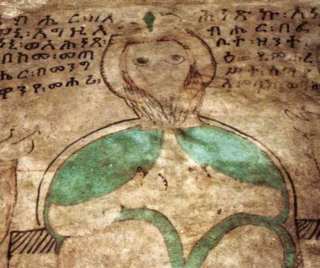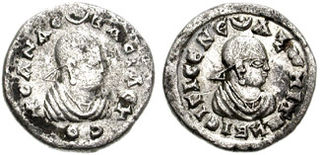
Menelik I was the legendary first Emperor of Ethiopia. According to Kebra Nagast, a 14th-century national epic, in the 10th century BC he is said to have inaugurated the Solomonic dynasty of Ethiopia, so named because Menelik I was the son of the biblical King Solomon of ancient Israel and of Makeda, the Queen of Sheba.

The emperor of Ethiopia, also known as the Atse, was the hereditary ruler of the Ethiopian Empire, from at least the 13th century until the abolition of the monarchy in 1975. The emperor was the head of state and head of government, with ultimate executive, judicial and legislative power in that country. A National Geographic article from 1965 called imperial Ethiopia "nominally a constitutional monarchy; in fact [it was] a benevolent autocracy".

Shewa, formerly romanized as Shua, Shoa, Showa, Shuwa, is a historical region of Ethiopia which was formerly an autonomous kingdom within the Ethiopian Empire. The modern Ethiopian capital Addis Ababa is located at its center.

The Solomonic dynasty, also known as the House of Solomon, was the ruling dynasty of the Ethiopian Empire from the thirteenth to twentieth centuries. The dynasty was founded by Yekuno Amlak, who overthrew the Zagwe dynasty in 1270. His successors claimed he was descended from the legendary king Menelik I, the supposed son of the biblical King Solomon and the Queen of Sheba, in order to legitimize the dynasty's assumption of power. Although this claimed ancestry gave the dynasty its name, there is no credible evidence that the dynasty was descended from Solomon or the Davidic line. The Solomonic dynasty remained in power until 1974, when its last emperor Haile Selassie was overthrown by a coup d'état.

The Zagwe dynasty was a medieval Agaw monarchy that ruled the northern parts of Ethiopia and Eritrea. The Agaw are a Cushitic ethnic group native to the northern highlands of Ethiopia and neighboring Eritrea. Centered at Roha, it ruled large parts of the territory from approximately 1137 to 1270 AD, when the last Zagwe King Za-Ilmaknun was killed in battle by the forces of the Amhara King Yekuno Amlak. The Zagwe are most famous for their king Gebre Mesqel Lalibela, who is credited with having ordered the construction of the rock-hewn monolithic churches of Lalibela.

Yekuno Amlak ; throne name Tesfa Iyasus was Emperor of Ethiopia, from 1270 to 1285, and the founder of the Solomonic dynasty, which lasted until 1974. He was a ruler from Bete Amhara who became the Emperor of Ethiopia following the defeat of the last Zagwe king.
Salomon III was Emperor of Ethiopia intermittently between 1796 and 1797, and a member of the Solomonic dynasty. He was the son of Tekle Haymanot II. He may be identical with the Emperor Solomon whom the traveler Henry Salt lists as one of the Emperors still alive at the time of his visit in 1809/1810. E. A. Wallis Budge notes some authorities believe he was the same person as Baeda Maryam II.
Demetros was Emperor of Ethiopia intermittently between 1799 and 1801, and a member of the Solomonic dynasty. He was the son of Arqedewos. He may be the same person as the "Adimo" mentioned in the account of the traveler Henry Salt who was dead by the time of Salt's visit to northern Ethiopia in 1809/1810.

Ousanas was a King of Axum. Stuart Munro-Hay believes that it is "very likely" that Ousanas is the king to whom Aedesius and Frumentius were brought. In Eritrean and Ethiopian tradition, this king is called Ella Allada or Ella Amida. Ella Amida would then be his throne name, although Ousanas is the name that appears on his coins. If this identification is correct, then it was during his reign that Christianity was introduced to Axum and the surrounding territories.
Wossen Seged was a Merid Azmach of Shewa, an Amhara noble of Ethiopia. He was the elder son of Asfa Wossen, by a woman of the Solomonic dynasty. He was the first ruler of Shewa to claim a higher title than Merid Azmach, calling himself Ras.

The Kingdom of Damot was a medieval kingdom in what is now western Ethiopia. The territory was positioned below the Blue Nile. It was a powerful state that forced the Sultanate of Showa to pay tributes. It also annihilated the armies of the Zagwe dynasty that were sent to subdue its territory. Damot conquered several Muslim and Christian territories. The Muslim state Showa and the new Christian state under Yekuno Amlak formed an alliance to counter the influence of Damot in the region.

Ethiopia is one of the oldest countries in Africa; the emergence of Ethiopian civilization dates back thousands of years. Abyssinia or rather "Ze Etiyopia" was ruled by the Semitic Abyssinians (Habesha) composed mainly of the Amhara, Tigrayans and the Cushitic Agaw. In the Eastern escarpment of the Ethiopian highlands and more so the lowlands were the home of the Harari/Harla that founded Sultanates such as Ifat and Adal and the Afars. In the central and south were found the ancient Sidama and Semitic Gurage, among others.
Ethiopian historiography includes the ancient, medieval, early modern, and modern disciplines of recording the history of Ethiopia, including both native and foreign sources. The roots of Ethiopian historical writing can be traced back to the ancient Kingdom of Aksum. These early texts were written in either the Ethiopian Ge'ez script or the Greek alphabet, and included a variety of mediums such as manuscripts and epigraphic inscriptions on monumental stelae and obelisks documenting contemporary events. The writing of history became an established genre in Ethiopian literature during the early Solomonic dynasty (1270–1974). In this period, written histories were usually in the form of royal biographies and dynastic chronicles, supplemented by hagiographic literature and universal histories in the form of annals. Christian mythology became a linchpin of medieval Ethiopian historiography due to works such as the Orthodox Kebra Nagast. This reinforced the genealogical traditions of Ethiopia's Solomonic dynasty rulers, which asserted that they were descendants of Solomon, the legendary King of Israel.
The 1922 regnal list of Ethiopia is an official regnal list used by the Ethiopian monarchy which names over 300 monarchs across six millennia. The list is partially inspired by older Ethiopian regnal lists and chronicles, but is notable for additional monarchs who ruled Nubia, which was known as Aethiopia in ancient times. Also included are various figures from Greek mythology and the Biblical canon who were known to be "Aethiopian", as well as figures who originated from Egyptian sources.
Regnal lists of Ethiopia are recorded lists of monarchs who are claimed by tradition to have ruled Ethiopia. These lists are often recorded on manuscripts or orally by monasteries and have been passed down over the centuries.

Angabo or Agabos was a legendary king of Ethiopia who killed the evil serpent king Arwe and was either the father or husband of the Queen of Sheba. He was sometimes called Za Besi Angabo.
Bazen was a king of Axum who reigned beginning in 8 B.C. according to various Ethiopian regnal lists in E.C. and around 1 B.C.-16 A.D in G.E..

Gebre Meskel also known as Gabra Masqal was a King of Axum who reigned in the 6th century. He was a son of Kaleb of Axum and brother to Israel of Axum. His reign is most notable for the compositions of hymns by the Ethiopian saint Yared.
Ayzur or Izoor was a king of Axum who reigned for half a day according to the traditional regnal lists.















